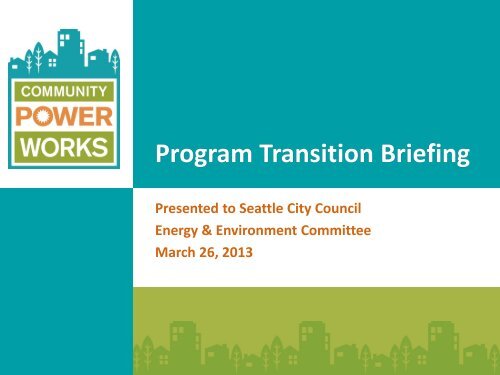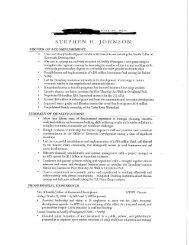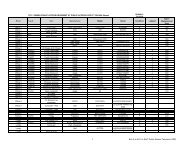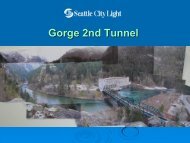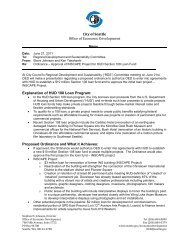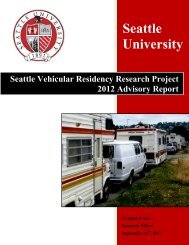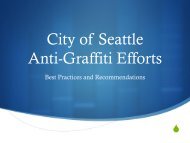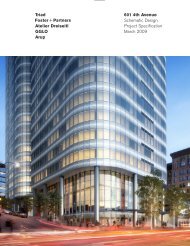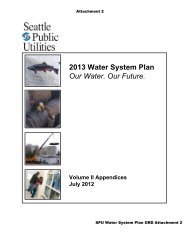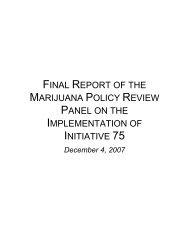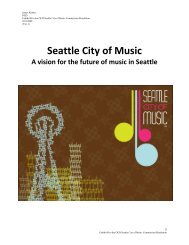Community Power Works Program Transition Presentation
Community Power Works Program Transition Presentation
Community Power Works Program Transition Presentation
You also want an ePaper? Increase the reach of your titles
YUMPU automatically turns print PDFs into web optimized ePapers that Google loves.
<strong>Program</strong> <strong>Transition</strong> Briefing<br />
Presented to Seattle City Council<br />
Energy & Environment Committee<br />
March 26, 2013
<strong>Community</strong> <strong>Power</strong> <strong>Works</strong> for Home<br />
<strong>Community</strong> <strong>Power</strong> <strong>Works</strong><br />
is an innovative pilot program designed to<br />
address three barriers to achieving deeper<br />
energy savings:<br />
• Information Barriers<br />
• Process Barriers<br />
• Funding Barriers
Information Barriers<br />
Before <strong>Community</strong> <strong>Power</strong> <strong>Works</strong>:<br />
• Homeowners were unaware of<br />
energy savings potential, or links to<br />
comfort and indoor air quality.<br />
After <strong>Community</strong> <strong>Power</strong> <strong>Works</strong>:<br />
• Energy Performance Score helps<br />
customers understand how their<br />
homes perform.<br />
• Contractors are kept abreast of<br />
program processes and utility<br />
incentives.<br />
• Contractors are provided support to<br />
improve their business models and<br />
customer interactions.
Process Barriers<br />
Before <strong>Community</strong> <strong>Power</strong> <strong>Works</strong>:<br />
• No coordinated service delivery was<br />
available for utilities’ incentives,<br />
which led to customer and contractor<br />
confusion.<br />
After <strong>Community</strong> <strong>Power</strong> <strong>Works</strong>:<br />
• On-call customer service gives<br />
customers an opportunity to address<br />
issues through a third party.<br />
• An IT platform tracks the workflow<br />
for the program, contractors, and<br />
customers.<br />
• Robust quality assurance is provided<br />
to ensure measures are successfully<br />
implemented.
Financial Barriers<br />
Before <strong>Community</strong> <strong>Power</strong> <strong>Works</strong>:<br />
• Homes heated by oil, propane, or<br />
wood do not have access to<br />
incentives.<br />
• With the Northwest’s low cost of<br />
energy, making energy efficiency<br />
cost-effective is challenging.<br />
After <strong>Community</strong> <strong>Power</strong> <strong>Works</strong>:<br />
• Additional rebates are available to<br />
incentivize deeper energy efficiency<br />
measures, as well as fuel conversion.<br />
• Competitive financing allows<br />
customers to amortize the costs of<br />
energy efficiency (up to 20 years).<br />
• Non-energy benefits – such as carbon<br />
reduction, health, and economic<br />
development – are not sufficiently<br />
factored in to cost-effectiveness tests.
Integrated Service Delivery Model<br />
1. SIGN UP<br />
2. ASSESS<br />
HOME<br />
3. UPGRADE<br />
HOME<br />
4. SAVE<br />
ENERGY<br />
5. GET<br />
PAID<br />
• Targeted marketing<br />
• $95 audit<br />
• Approved auditors<br />
• EPS<br />
• Approved contractors • Third-party test out • Incentives<br />
• Rebates<br />
• Financing<br />
• On-bill repayment<br />
Accessible IT platform<br />
Robust customer service<br />
Quality assurance/quality control
Progress Toward Residential Goal<br />
2,040 upgrades complete<br />
or in progress, including:<br />
Residential Goal = 2,070 units<br />
728 HomeWise multifamily<br />
units<br />
262 HomeWise singlefamily<br />
homes<br />
1,050 single-family homes<br />
• Homeowners with <strong>Community</strong><br />
<strong>Power</strong> <strong>Works</strong> are projected to see<br />
30% average energy savings.<br />
• 100 homes are achieving more<br />
than 50% energy savings.
Where Do We Go From Here?
Advisory Group: What We Heard<br />
• While it should partner with utilities, <strong>Community</strong> <strong>Power</strong> <strong>Works</strong> should<br />
not live within, or be completely funded by, a utility.<br />
• <strong>Community</strong> <strong>Power</strong> <strong>Works</strong> has developed assets that can live on in<br />
different parts of the community.<br />
• Office of Sustainability & Environment should conduct a process to<br />
identify a partner to implement the program after the grant ends.
Future of <strong>Community</strong> <strong>Power</strong> <strong>Works</strong> Assets<br />
Marketing<br />
Advocacy<br />
Contractor Certification<br />
Contractor Support<br />
Lead Generation<br />
Customer Service<br />
QA/QC/Reporting<br />
IT Portal<br />
Financing<br />
Incentives<br />
Statewide/Regional Partner<br />
<strong>Community</strong> <strong>Power</strong> <strong>Works</strong><br />
Financial Partners<br />
Utility Partners<br />
10
Needs Going Forward<br />
<strong>Community</strong> <strong>Power</strong> <strong>Works</strong>:<br />
‣ Federal grant support for <strong>Community</strong> <strong>Power</strong> <strong>Works</strong> will end September 30,<br />
2013. If the program is to move beyond the grant-funded pilot, the City<br />
needs to identify the partner that will assume on-going program<br />
implementation.<br />
Seattle City Light Residential Incentives:<br />
‣ Seattle City Light (SCL) has piloted residential energy savings incentives<br />
through <strong>Community</strong> <strong>Power</strong> <strong>Works</strong>, and plans to expand the residential<br />
incentives to their entire service territory.<br />
‣ For expansion, SCL is interested in working with a third party to deliver the<br />
residential incentives, and there may be an opportunity to work with the<br />
same partner selected for <strong>Community</strong> <strong>Power</strong> <strong>Works</strong>.
Process Moving Forward<br />
• OSE will issue a Request for Qualifications (RFQ) to identify a non-profit<br />
partner. OSE and SCL are working together to scope the RFQ such that the<br />
selected partner meets the needs of both departments.<br />
• Over the summer and fall, OSE work with the selected partner to conduct<br />
business plan feasibility to determine if there is a viable future for<br />
<strong>Community</strong> <strong>Power</strong> <strong>Works</strong> (including solidifying strategic partnerships and<br />
necessary funding).<br />
• If a path forward is identified, the partner would manage the program<br />
transition and would assume program implementation going forward.<br />
The City would remain a partner.
Release RFQ – March 29<br />
<strong>Community</strong> <strong>Power</strong> <strong>Works</strong> <strong>Transition</strong> Timeline<br />
Announcement of successful respondent(s) – early-June<br />
MOU execution – late-June<br />
Business Plan Development – though November<br />
Contract Signed – November<br />
MAR APR MAY JUN JUL AUG SEPT OCT NOV DEC<br />
2014<br />
Seattle City Light<br />
Incentive <strong>Program</strong> Scaling<br />
Successful respondent(s)<br />
negotiate contract with<br />
Seattle City Light<br />
If CPW not feasible, SCL contracts<br />
with partner and implements<br />
stand-alone incentive program<br />
If deemed feasible, SCL and OSE<br />
contract separately with new CPW<br />
program that delivers SCL incentives<br />
13
Questions?


